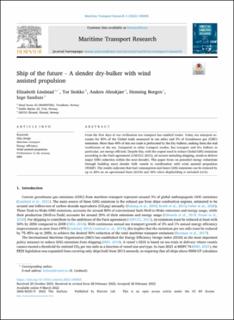| dc.contributor.author | Lindstad, Elizabeth | |
| dc.contributor.author | Stokke, Tor | |
| dc.contributor.author | Alterskjær, Anders | |
| dc.contributor.author | Borgen, Henning | |
| dc.contributor.author | Sandaas, Inge | |
| dc.date.accessioned | 2022-10-27T07:27:24Z | |
| dc.date.available | 2022-10-27T07:27:24Z | |
| dc.date.created | 2022-04-19T17:44:05Z | |
| dc.date.issued | 2022 | |
| dc.identifier.citation | Maritime Transport Research. 2022, 3 1-11. | en_US |
| dc.identifier.issn | 2666-822X | |
| dc.identifier.uri | https://hdl.handle.net/11250/3028547 | |
| dc.description.abstract | From the first days of our civilization sea transport has enabled trades. Today sea transport accounts for 80% of the Global trade measured in ton miles and 3% of Greenhouse gas (GHG) emissions. More than 40% of this sea trade is performed by the Dry bulkers, making them the real workhorses of the sea. Compared to other transport modes, Sea transport and Dry bulkers in particular, are energy efficient. Despite this, with the urgent need to reduce Global GHG emissions according to the Paris agreement (UNFCCC 2015), all sectors including shipping, needs to deliver major GHG reduction within the next decades. This paper focus on potential energy reductions through building more slender bulk vessels in combination with wind assisted propulsion (WASP). The results indicates that fuel consumption and hence GHG emissions can be reduced by up to 40% on an operational basis (EEOI) and 30% when shipbuilding is included (LCA). | en_US |
| dc.language.iso | eng | en_US |
| dc.publisher | Elsevier | en_US |
| dc.rights | Navngivelse 4.0 Internasjonal | * |
| dc.rights.uri | http://creativecommons.org/licenses/by/4.0/deed.no | * |
| dc.subject | IMO | en_US |
| dc.subject | Performance in the seaway | en_US |
| dc.subject | Wind assisted propulsion | en_US |
| dc.subject | Energy efficiency | en_US |
| dc.subject | Maritime transport | en_US |
| dc.subject | Ship design | en_US |
| dc.title | Ship of the future – A slender dry-bulker with wind assisted propulsion | en_US |
| dc.title.alternative | Ship of the future – A slender dry-bulker with wind assisted propulsion | en_US |
| dc.type | Peer reviewed | en_US |
| dc.type | Journal article | en_US |
| dc.description.version | publishedVersion | en_US |
| dc.rights.holder | © 2022 The Authors. Published by Elsevier Ltd | en_US |
| dc.source.pagenumber | 1-11 | en_US |
| dc.source.volume | 3 | en_US |
| dc.source.journal | Maritime Transport Research | en_US |
| dc.identifier.doi | 10.1016/j.martra.2022.100055 | |
| dc.identifier.cristin | 2017671 | |
| dc.relation.project | Norges forskningsråd: 237917 | en_US |
| dc.relation.project | Norges forskningsråd: 294771 | en_US |
| dc.source.articlenumber | 100055 | en_US |
| cristin.ispublished | true | |
| cristin.fulltext | original | |
| cristin.qualitycode | 1 | |

